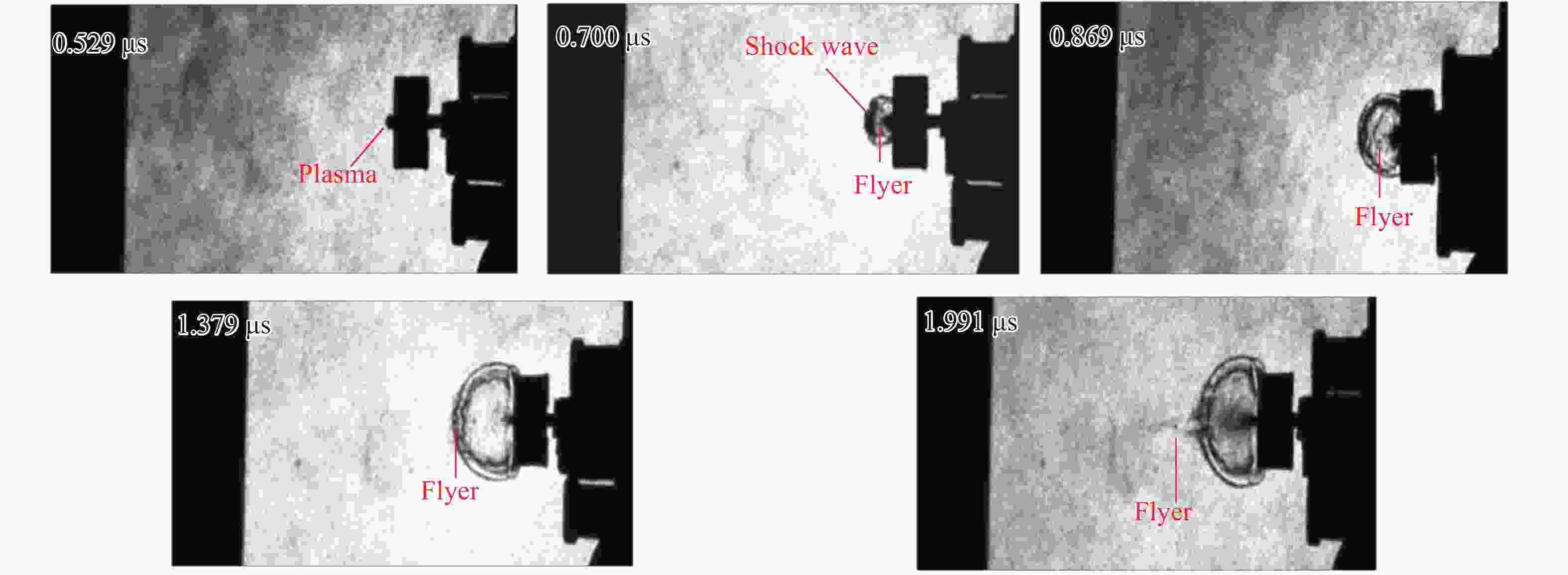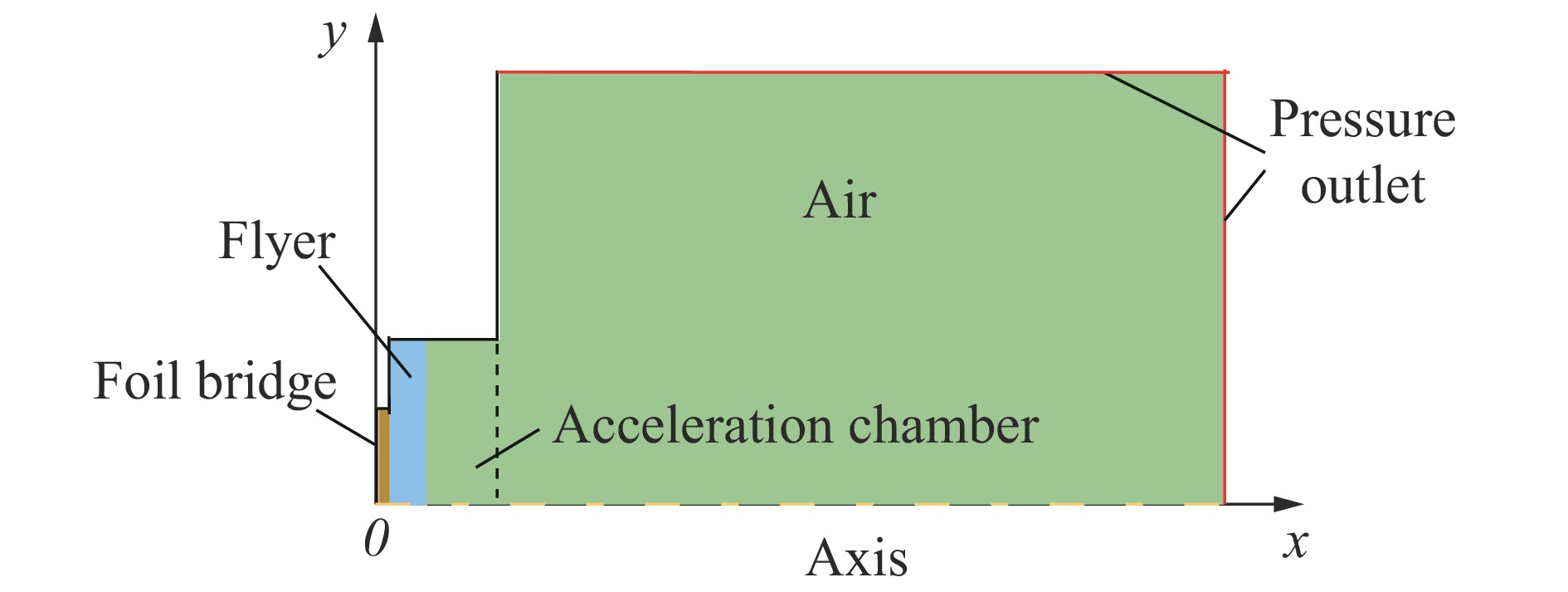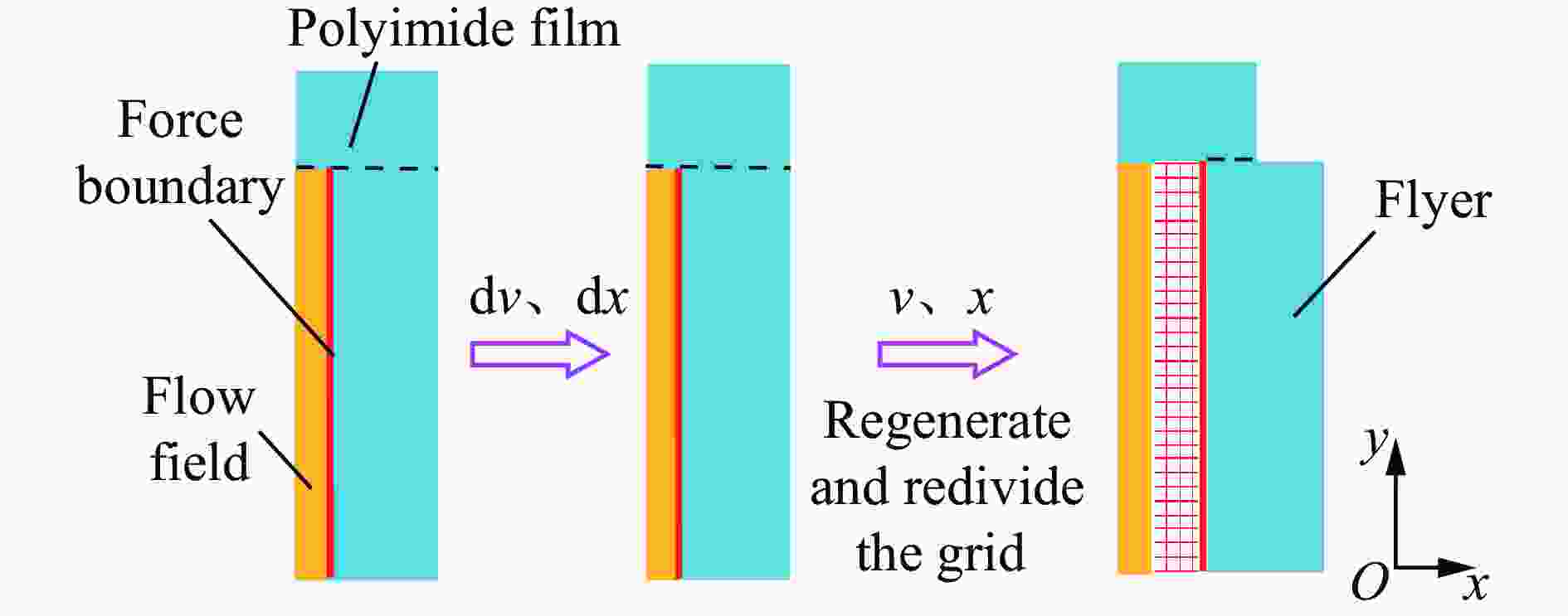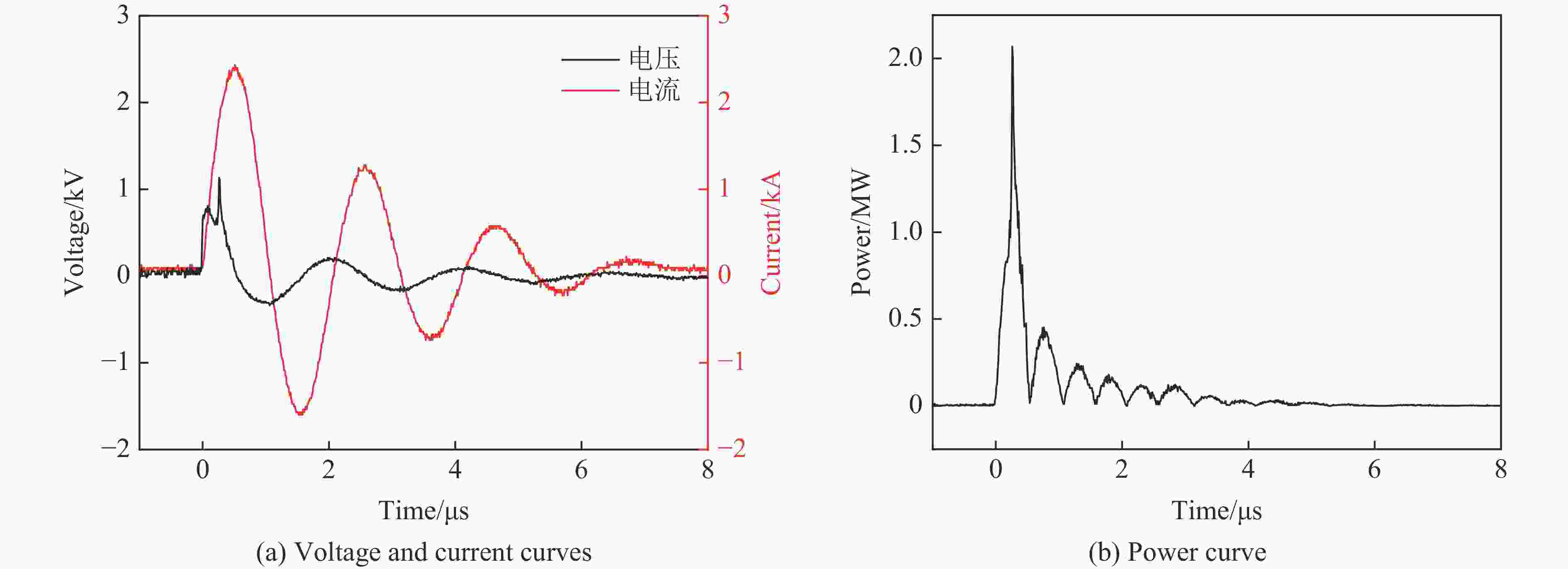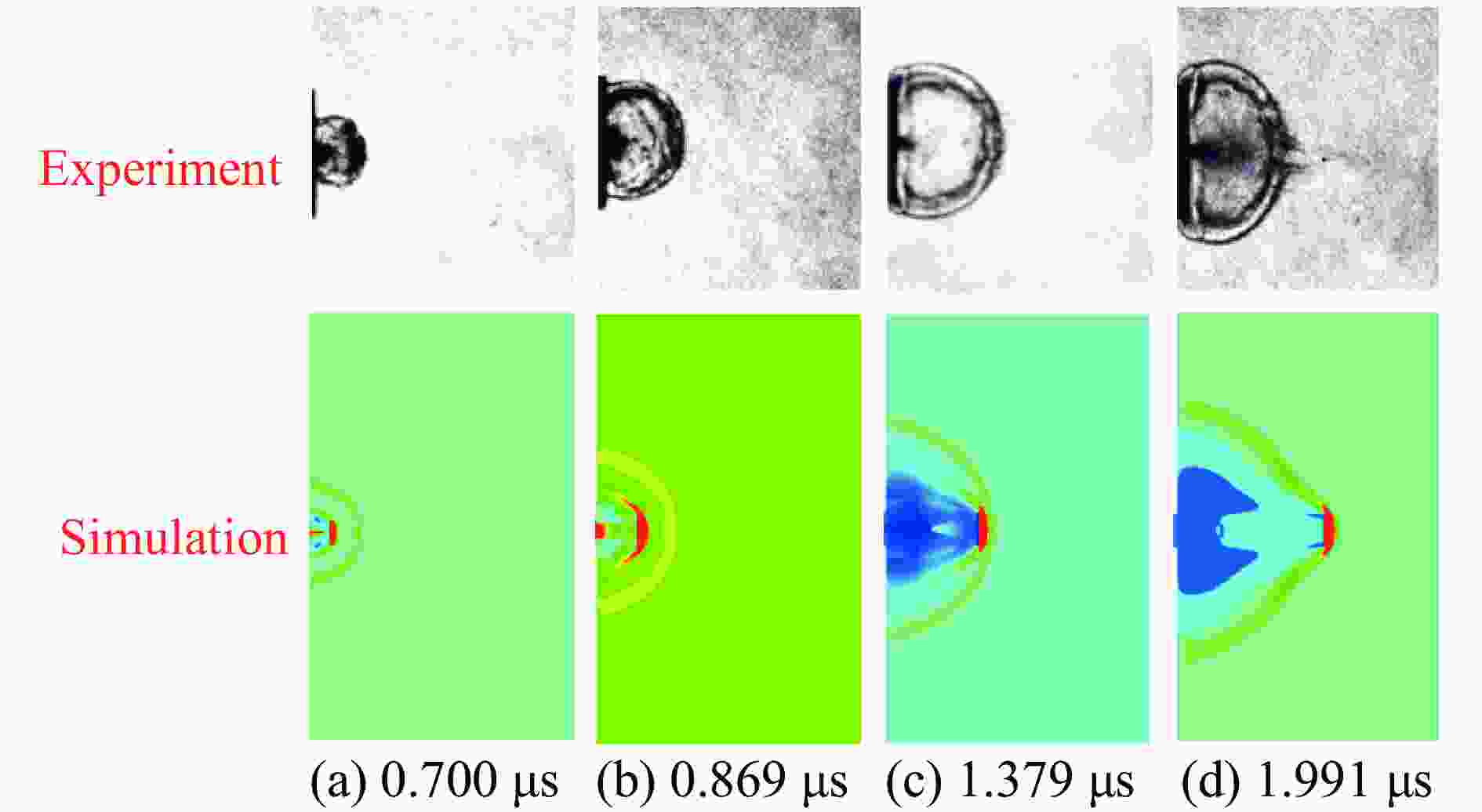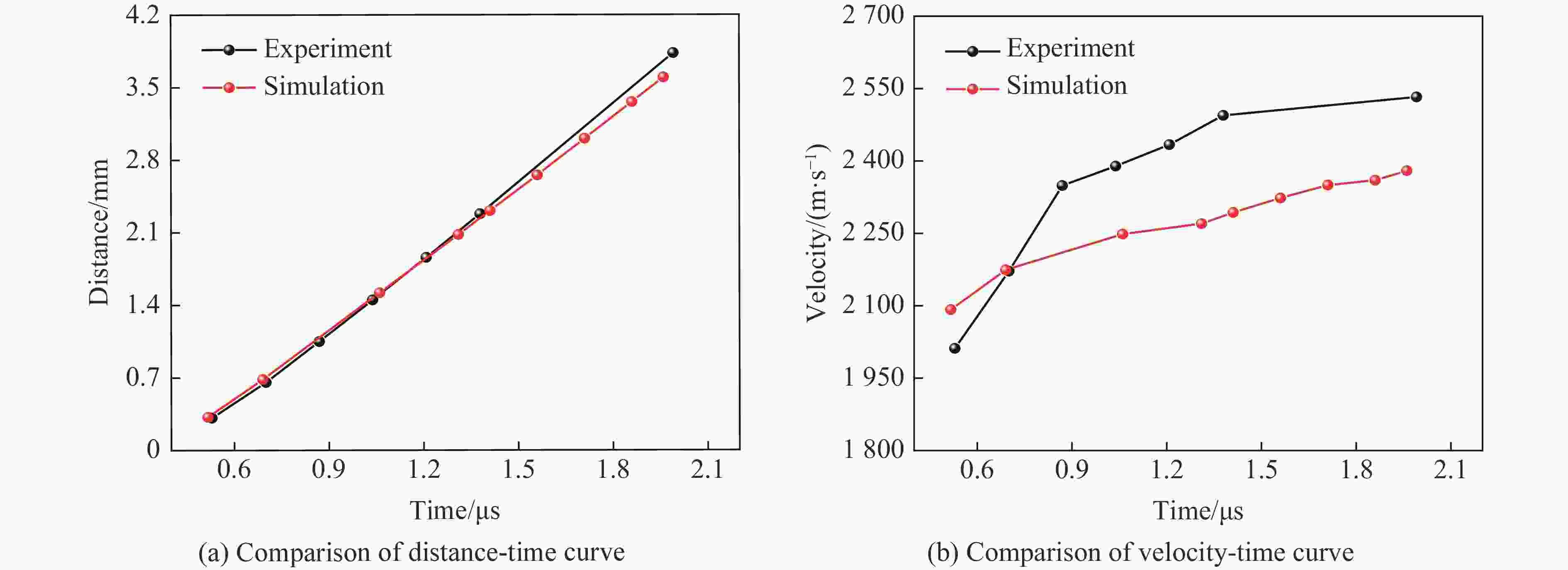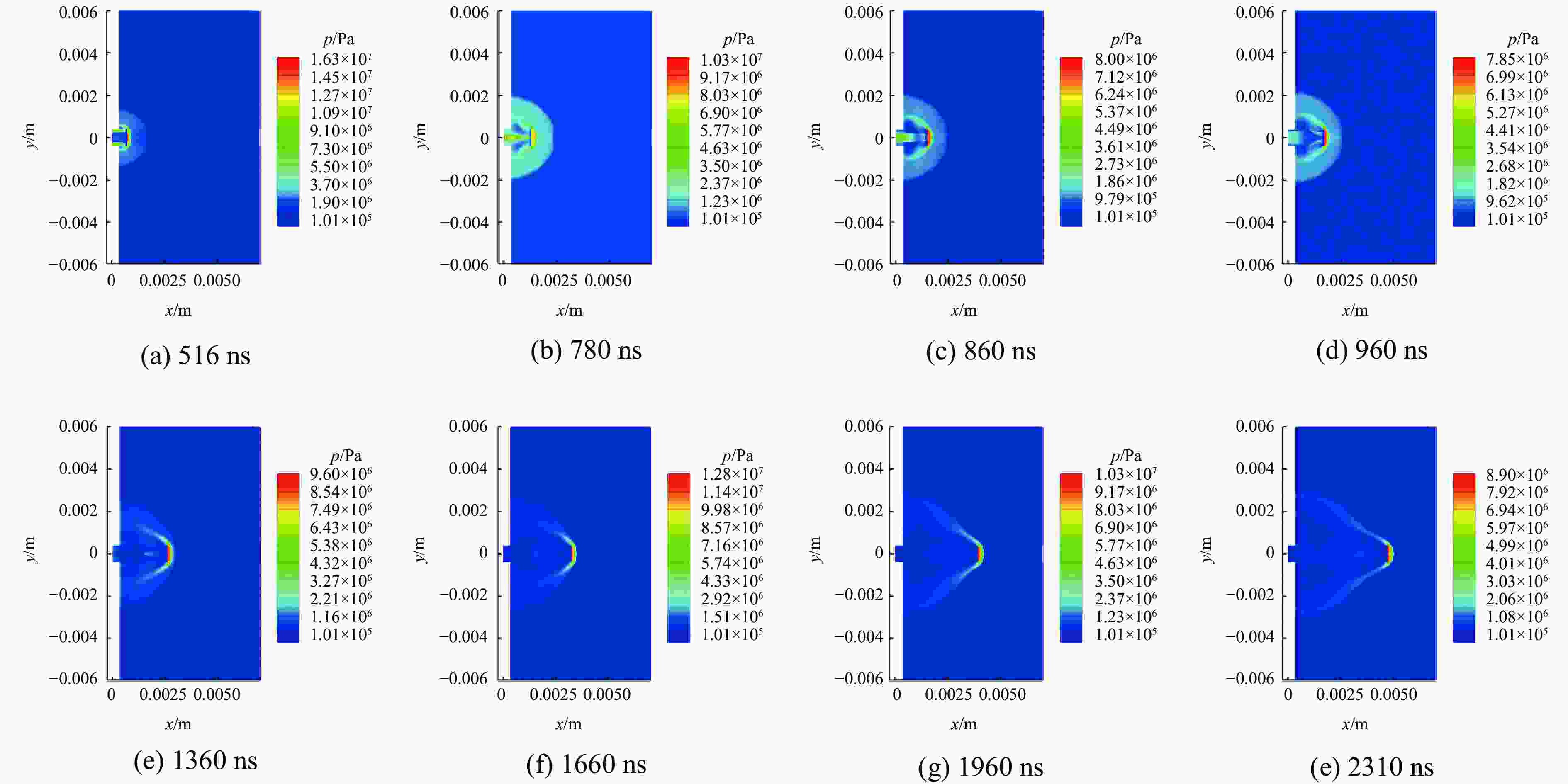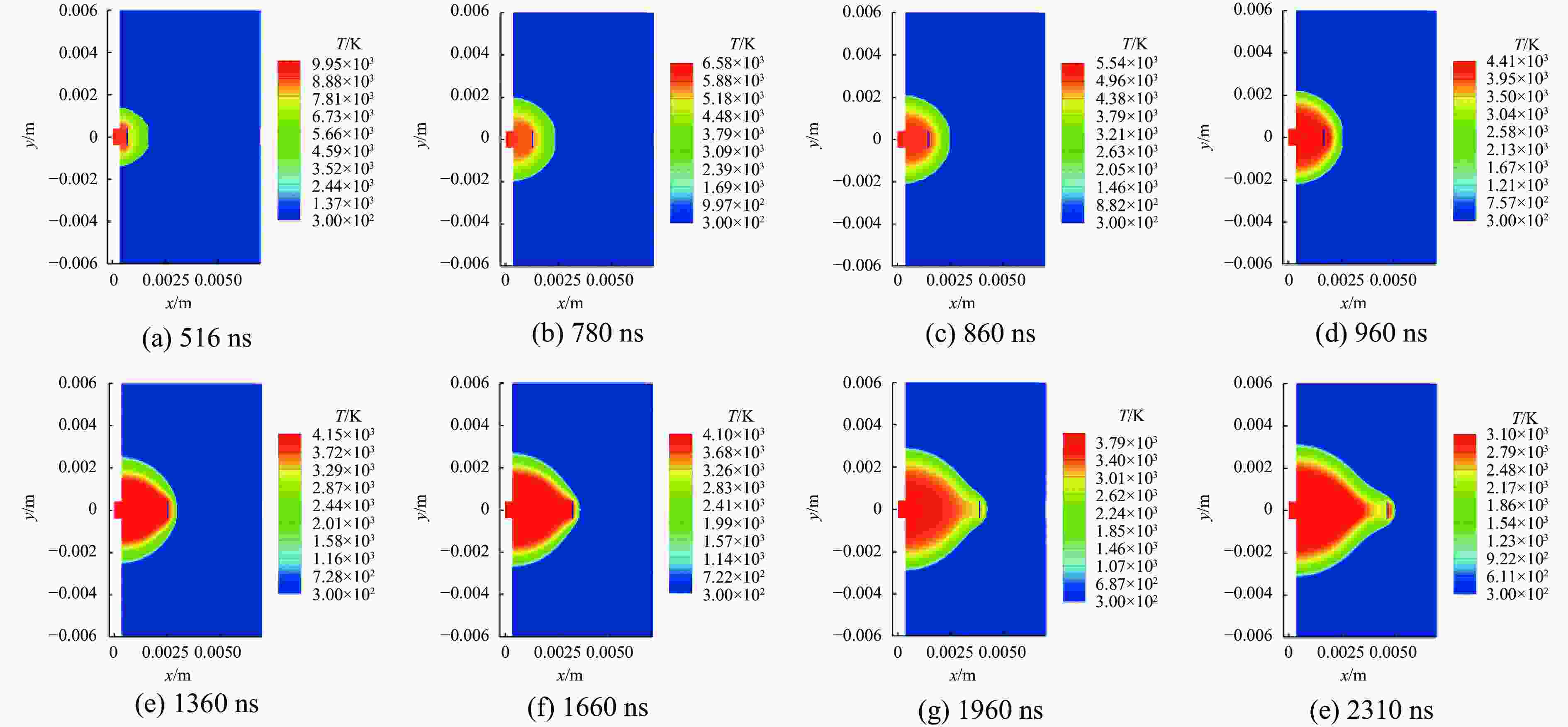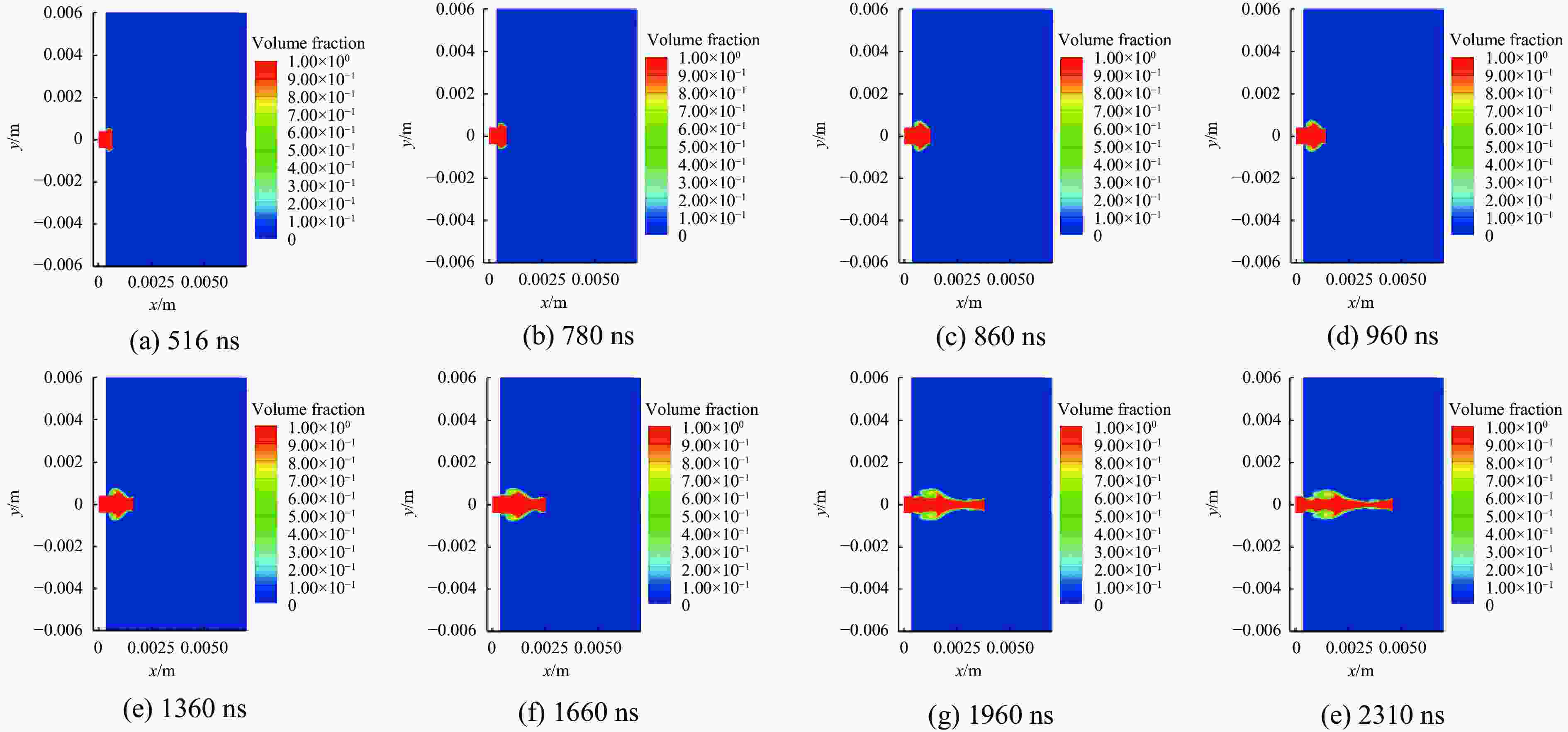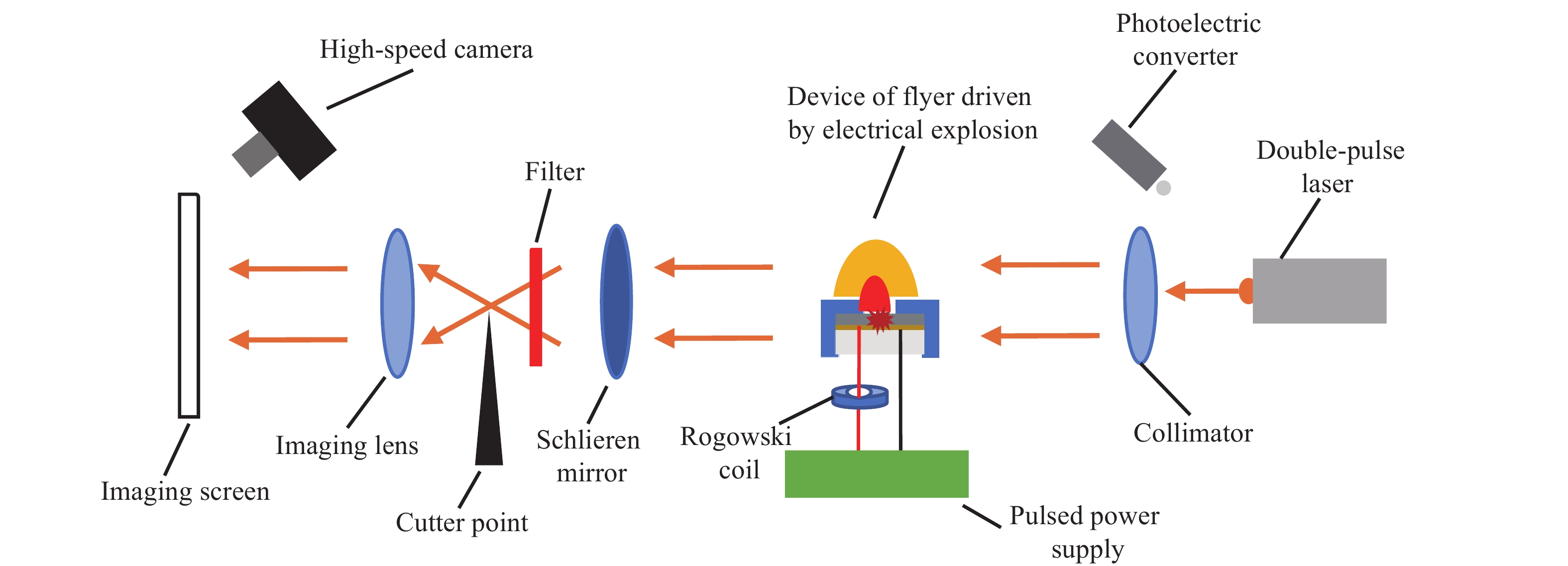Transient observation and numerical simulation study on the flow field of flyer driven by the electric explosion of metal foil
-
摘要: 金属桥箔电爆炸驱动绝缘飞片的冲击起爆与点火技术在武器装备的起爆与点火系统中被广泛应用。为弥补现有研究对飞片运动过程中流场演化规律描述不足的缺陷,促进该技术向能量高效利用以及小型化等方面发展,搭建了双脉冲激光纹影瞬态观测实验系统,获得了不同时刻下流场的密度分布以及飞片的运动距离,同时,建立了金属桥箔电爆炸驱动飞片运动过程的二维轴对称流体动力学计算模型与计算方法,计算充分考虑了加速膛内外流场在飞片运动、冲击波压缩以及高温高压等离子体膨胀等作用下的演化规律,采用相变体积分数法描述桥箔在电能作用下由固相到等离子体相的转变,建立了等离子体状态方程以准确描述等离子体的状态,采用动网格模型描述了飞片在流场驱动下的运动。计算与实验得到的流场密度分布具有较好的贴合性,且飞片运动距离和飞片运动速度的最大误差分别为6.1%与8.1%,验证了计算模型与计算方法的准确性。研究结果表明:电容为0.33 μF、起爆电压为
2800 V时,研究范围内,流场压强最大值基本维持在1×107 Pa左右;流场温度逐渐从516 ns时刻的9950 K降低到2310 ns时的3100 K;流场等离子体相分布逐渐由扁平状发展为长条状,等离子体相与飞片运动垂直方向的最大扩散距离为0.8 mm。1360 ns后,由于飞片突破冲击波波阵面,流场压强分布与温度分布的前端突起。Abstract: Shock initiation and ignition techniques driven by electrically exploded metallic bridge foils with insulating flyers have been widely implemented in initiation and ignition system of weapon. To address the deficiency in existing research regarding the description of the flow field evolution during the motion of flyer and promote the development of this technology towards efficient energy utilization and miniaturization, a double-pulse laser schlieren transient observation system was constructed. This system enables the acquisition of density distributions of the flow field and the motion distance of the flyer at different time. Additionally, a two-dimensional axisymmetric fluid dynamics calculation model and calculation method for the motion process of flyer driven by the electric explosion of metal foil were established, and corresponding numerical simulation calculations were performed in consideration of the evolution laws of the flow field inside and outside the acceleration chamber under the effects of the motion of flyer, the compression of shock wave, and the expansion of high-temperature and high-pressure plasma. The phase transition of bridge foil from solid phase to plasma phase was described by phase transition fraction, the state of plasma with high temperature and pressure was described by the state equation of plasma which consider the changes in particle number and coulomb interaction between particles, and the motion of flyer was described by dynamic grid model. The calculated flow field density distribution closely matches the experimental results, and the maximum errors in flyer motion distance and velocity are 6.1% and 8.1%, respectively, validating the accuracy of the calculation model and calculation method. The research results indicate that when the capacitance is 0.33 μF and the initiation voltage is2800 V, within the research range, the maximum pressure in the flow field remains approximately at 1×107 Pa; the temperature in the flow field gradually decreases from9950 K at 516 ns to3100 K at2310 ns; and the plasma phase distribution in the flow field gradually evolves from a flat shape to a long strip shape, with the maximum diffusion distance of plasma in the direction perpendicular to the motion of the flyer being 0.8 mm. At1360 ns, upon flyer breakthrough the shock wave front, a distinct bulge-shaped profile emerges in the leading edge of both pressure and temperature distributions within the flow field.-
Key words:
- metal foil /
- electric explosion /
- flyer /
- flow field
-
表 1 相关材料物性参数
Table 1. Physical properties of related materials
材料 密度/(kg∙m−3) 热导率/(W∙m−1∙K−1) 热容/(J∙kg−1∙K−1) 汽化热/(J∙kg−1) 汽化温度/K 剪切模量/GPa 铜 8960 380.1 420 4.8×106 2836 - 空气 1.225 0.0242 1006.43 - - - 聚酰亚胺 1420 0.4 1090 - - 1.04 -
[1] LEE R S, OSHER J E, CHAU H H, et al. 1 MJ electric gun facility at LLNL: UCRL-JC-108530 [R]. Livermore: Lawrence Livermore National Laboratory, 1992. [2] LOGAN J D, LEE R S. EBF1: a computer simulation of the preburst behavior of electrically heated exploding foils: UCRL-52003 [R]. Livermore: Lawrence Livermore National Laboratory, 1976. [3] MURPHY M J, ADRIAN R J. Particle response to shock waves in solids: dynamic witness plate/PIV method for detonations [J]. Experiments in Fluids, 2007, 43(2/3): 163–171. DOI: 10.1007/s00348-007-0254-x. [4] WILLEY T M, CHAMPLEY K, HODGIN R, et al. X-ray imaging and 3D reconstruction of in-flight exploding foil initiator flyers [J]. Journal of Applied Physics, 2016, 119(23): 235901. DOI: 10.1063/1.4953681. [5] WANG Y, GUO F, WANG W J, et al. Improved exploding properties of Al/Cu multilayer initiators [J]. Propellants, Explosives, Pyrotechnics, 2020, 45(11): 1698–1704. DOI: 10.1002/prep.202000047. [6] HROUSIS C A, CHRISTENSEN J S. Progress in initiator modeling: LLNL-CONF-413208 [R]. Livermore: Lawrence Livermore National Laboratory, 2009. [7] SAXENA A K, KAUSHIK T C, GUPTA S C. Shock experiments and numerical simulations on low energy portable electrically exploding foil accelerators [J]. Review of Scientific Instruments, 2010, 81(3): 033508. DOI: 10.1063/1.3327818. [8] 程立. 某冲击片雷管作用过程数值仿真与可靠性评估研究 [D]. 北京: 北京理工大学, 2016. DOI: 10.26948/d.cnki.gbjlu.2016.000340.CHENG L. Study on reliability evaluation and action process numerical simulation of slapper detonator [D]. Beijing: Beijing Institute of Technology, 2016. DOI: 10.26948/d.cnki.gbjlu.2016.000340. [9] 钱石川, 甘强, 任志伟, 等. 桥箔电爆炸驱动飞片的数值模拟 [J]. 北京理工大学学报, 2017, 37(S2): 125–127,136.QIAN S C, GAN Q, REN Z W, et al. Numerical simulation of flyer driven by electric explosion of bridge foil [J]. Transactions of Beijing Institute of Technology, 2017, 37(S2): 125–127,136. [10] XU C, LIU Z G. Numerical analysis on acceleration process and shock initiation of parylene C−Cu flyer in exploding foil initiator [J]. Propellants, Explosives, Pyrotechnics, 2022, 47(5): e202100321. DOI: 10.1002/prep.202100321. [11] 伍俊英, 殷宇, 郑富德, 等. 金属桥箔电爆炸驱动飞片过程数值模拟研究 [J]. 北京理工大学学报, 2024, 44(4): 336–347. DOI: 10.15918/j.tbit1001-0645.2023.095.WU J Y, YIN Y, ZHENG F D, et al. Numerical simulation of metal bridge foil electric explosion driving flyer [J]. Transactions of Beijing Institute of Technology, 2024, 44(4): 336–347. DOI: 10.15918/j.tbit1001-0645.2023.095. [12] 殷宇. 金属桥箔电爆炸驱动飞片实验与数值模拟研究 [D]. 北京: 北京理工大学, 2023. [13] 寇永锋. 火炸药装药烤燃反应特征及热安全性研究 [D]. 北京: 北京理工大学, 2022. [14] 陈华. 聚酰亚胺材料的力学化学特性及其超高速碰撞效应研究 [D]. 长沙: 国防科学技术大学, 2013.CHEN H. Research on the mechanical and chemical properties of polyimide and its influence on hypervelocity impact phenomena [D]. Changsha: National University of Defense Technology, 2013. [15] 李雅瑟, 伍俊英, 汪龙, 等. 阵列桥箔电爆炸过程数值模拟 [J]. 北京理工大学学报, 2017, 37(S2): 153–157.LI Y S, WU J Y, WANG L, et al. Numerical simulation of array bridge foil electrical exploding [J]. Transactions of Beijing Institute of Technology, 2017, 37(S2): 153–157. [16] WU J Y, WANG L, LI Y S, et al. Characteristics of a plasma flow field produced by a metal array bridge foil explosion [J]. Plasma Science and Technology, 2018, 20(7): 075501. DOI: 10.1088/2058-6272/aab783. [17] MOŚCICKI T, HOFFMAN J, SZYMAŃSKI Z. Modelling of plasma formation during nanosecond laser ablation [J]. Archives of Mechanics, 2011, 63(2): 99–116. [18] JOHNSTON M D, HAHN K, OLIVER B V, et al. Volumetric plasma source development and characterization: SAND2008-6161 [R]. Albuquerque: Sandia National Laboratories, 2008. DOI: 10.2172/942062. [19] ZHAO J P, ZHANG Q G, YAN W Y, et al. Plasma characteristics of single aluminum wire electrically exploded in high vacuum [J]. IEEE Transactions on Plasma Science, 2013, 41(8): 2207–2213. DOI: 10.1109/TPS.2013.2248098. [20] ROZMAN R, GRABEC I, GOVEKAR E. Influence of absorption mechanisms on laser-induced plasma plume [J]. Applied Surface Science, 2008, 254(11): 3295–3305. DOI: 10.1016/j.apsusc.2007.11.029. [21] 王飞. 激光作用下等离子体爆轰波特性及驱动飞片研究 [D]. 北京: 北京理工大学, 2013. [22] 伍俊英, 于红新, 汪龙, 等. 金属桥箔水中电爆炸流场数值模拟研究 [J]. 兵工学报, 2016, 37(S1): 51–56.WU J Y, YU H X, WANG L, et al. Numerical simulation of electric exploding of metal bridge foil in water [J]. Acta Armamentarii, 2016, 37(S1): 51–56. -






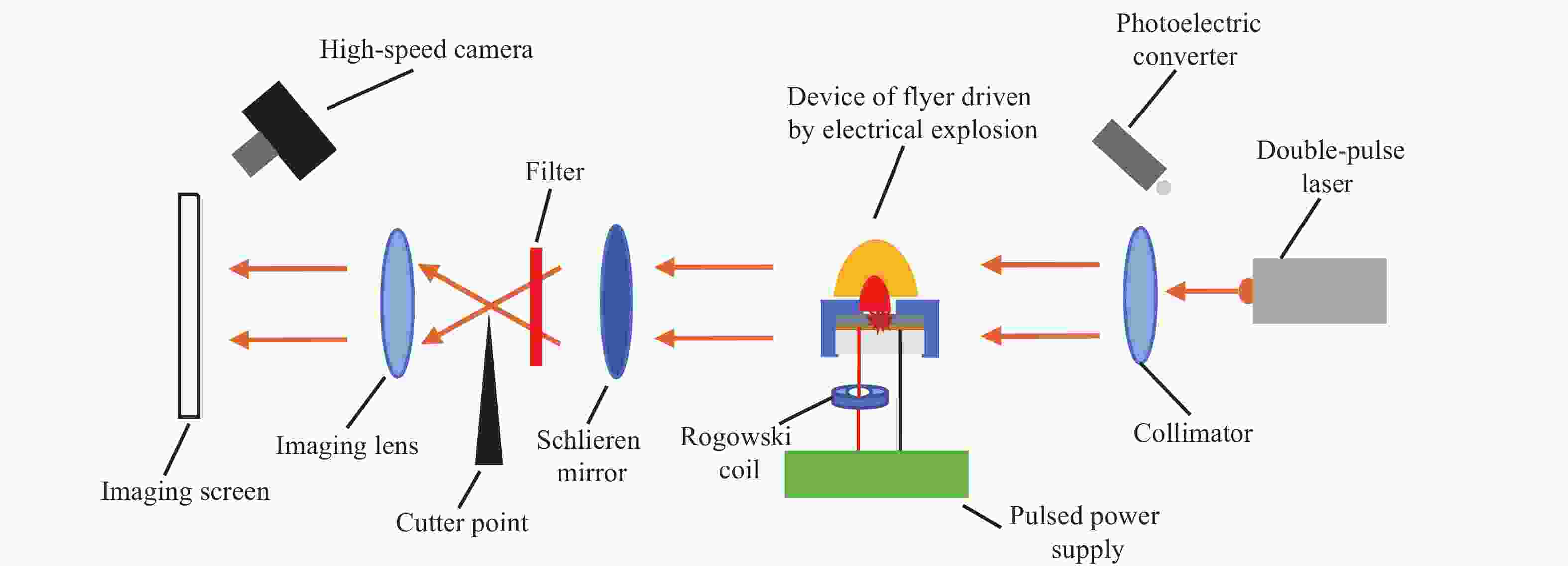
 下载:
下载:

